Mackerel:
What is it?, history, cultivation, nutritional value, uses, recipes, and more...
The mackerel (Trachurus murphyi) is a pelagic fish found in waters adjacent to Ecuador, Peru, Chile, New Zealand, Australia, and the Subtropical Convergence Zone. Among the main benefits of its consumption are its contributions of omega-3 fatty acids, proteins, vitamins, and minerals.
Índice
What is Mackerel?
Mackerel is a neritic and oceanic pelagic fish that inhabits the coasts of the southern Pacific Ocean and thrives in areas far from the coast, preferring sandy bottoms at depths of up to 300 meters. It is a migratory fish that forms large schools, often coexisting with different species. It can also be found in the waters of the Atlantic Ocean, the Black Sea, and the Mediterranean Sea.
It has an elongated and compressed body with large scales. It displays a bluish-green color on its dorsal side and silver on its belly with white spots. It also features a dark spot near the posterior part of the operculum (the area covering the gills). It measures approximately 40 centimeters, although it can reach up to 70 cm in length and weigh, on average, around one kilogram. The fish has a large head, with the upper jaw coming close to the eye orbit, and it has a venomous spine on its dorsal fin, which requires caution as its sting is quite painful.
History of Mackerel
Evidence suggests that ancient Peruvian populations were already fishing and consuming mackerel in significant quantities. Recent excavations in Quebrada de los Burros have shown that between 10,000 and 6,000 years BP, during the early and middle Holocene (early pre-ceramic period), there were fishermen and mollusk gatherers who regularly engaged in mackerel fishing (Lavallée et al., 2011).
Later, during the beginning of the ceramic period 3,800 years BP, numerous pieces of evidence have been found of the development of fishing villages from various pre-Hispanic cultures that occupied the Peruvian coastline, such as the Ancón, Chancay, Chimú, Cupisnique, Lima, Moche, Nazca, Pachacámac, Paita, Paracas, Sicán, Wari, and other cultures that preceded the Inca culture (Lumbreras et al., 2008, Pérez et al., 1976). A large number of fish bones were discovered, predominantly those of mackerel T. murphyi, indicating regular consumption of this species, particularly in ceremonial banquets (Moseley et al., 2005).
Furthermore, there are numerous huacos, vessels, and other sculptural ceramics depicting scenes of navigation and fishing left behind by ancient Peruvians, leaving no doubt about their consumption of mackerel. There are also indications that during the pre-ceramic period, boats were already used for fishing, which could have been similar to those used in the ceramic period, although there is no evidence of this.
With the arrival of the Spanish in the 16th century, fishing techniques improved and the use of more advanced European vessels and materials began. According to chronicles from that time, it was common for street vendors to offer their goods and products by walking through the streets of Lima and other cities. Among them were fishermen. However, mackerel was not yet a valued food during that era.
In the early 20th century, mackerel was considered an abundant species along the entire Peruvian coast (Coker, 1907, 1910). However, for much of the 20th century, it was among the least preferred options for fishermen and the Peruvian population in general.
Only in the late 1960s did mackerel begin to occupy intermediate positions in fish landing statistics, with rapidly increasing annual catches that quickly rose from hundreds to thousands of tons per year. By 1974, 129 thousand tons of this species were caught. With this, mackerel T. murphyi moved into second place in national landing statistics, just behind anchovy.
Currently, mackerel fishing is the third most important in Peru, following only anchovy and squid; and it ranks sixth in non-traditional exports (MINCETUR, 2021). In terms of the domestic market, it is widely consumed by Peruvians, with an average consumption of 3.9 kilograms per capita per year, surpassing skipjack tuna and mackerel with 3.23 and 1.39 kilograms, respectively.

Common Name of Mackerel
| Spanish | Jurel, burel, chicharro, xurelo, xirel |
| Portugues | Carapau |
| French | Chinchard |
| English | Jack mackerel Atlantic horse mackerel |
| Name FAO | Jurel del Pacífico Sur |
Scientific Name of Mackerel
Trachurus murphyi
Taxonomy of Mackerel
| Kingdom | Animalia |
| Phylum | Chordata |
| Subphylum | Magnoliopsida |
| Order | Vertebrata |
| Class | Osteichthes |
| Subclass | Sarcoptherygii |
| Infraclase | Teleostei |
| Order | Peciformes |
| Family | Carangidae |
| Gender | Trachurus |
| Specie | Trachurus simmetricus |
| Sub Specie | Trachurus simmetricus murphyi |
Synonyms of Mackerel
- Caranx chilensis
- Caranx trachurus
- Trachurus
- Trachurus picturatus
- Trachurus symmetricus
- Trachurus symmetricus murphyi
Etymology of Mackerel
The word “mackerel” originates from Hispano-Arabic “šuríl,” which is a diminutive of the Latin word “saurus,” derived from the Greek “σαῦρος,” meaning lizard.
Reproduction of Mackerel
- Reproduction
Mackerel is distributed from Ecuador in the north to 52ºS, and from the coast of South America to the east, to the coastal waters of New Zealand and Tasmania Island (Australia) to the west. This distribution area is known as the "mackerel belt" of the South Pacific. It is found at depths of up to 300 meters.
In Peru, this marine species is distributed along the entire coastline and extends more than 160 nautical miles from the coast.
Mackerel is a gregarious species that forms schools, and its preferred habitat is the oceanic front formed by the Cold Coastal Waters (ACF) and the Superficial Subtropical Waters (ASS). The fronts and eddies that form between these water masses seem to have an effect on certain biological and behavioral characteristics. The distribution and concentration of schools along the coast are related to the variation and interaction of water masses. During summer or warm years (El Niño), they tend to approach the coast, while during the winter months or cold years (La Niña), they move away.
Mackerel is a heterosexual species without visible sexual dimorphism. It reproduces externally, presenting partial spawning, which occurs from late winter to spring. Its main spawning area is located between 14º00' and 18º30' S of our coast, in the oceanic front bordered by intense upwelling ACF and ASS, generally between 100 and 150 nautical miles from the coast.
While its reproductive activity occurs throughout the year, the main spawning phase takes place between October and January. During this period, a significant migration of spawning individuals towards the West, away from the coast, is recorded.
Geographical Distribution of Mackerel

Piura, Lambayeque, La libertad, Ancash, Lima, Ica, Arequipa, Moquegua, Tacna
Seasonal Availability of Mackerel
- Year-round
Varieties of Mackerel
Other species called “mackerel” include the following:
-
Species:
Alectis alexandrina, jurel de Alejandría. Alectis ciliaris, jurel de pluma. Alepes djedaba, jurel subarí. Alepes melanoptera, jurel alinegro. Alepes vari, jurel arenque. Atule mate, jurel rabo amarillo. Carangoides armatus, jurel sap-sap. Carangoides bajad, jurel lentejuela. Carangoides coeruleopinnatus, jurel costero. Carangoides chrysophrys, jurel tapir. Carangoides dinema, jurel crepúsculo. Carangoides equula, jurel aliblanco. Carangoides ferdau, jurel manchado. Carangoides fulvoguttatus, jurel centellante. Carangoides gymnostethus, jurel balo. Carangoides hedlandensis, jurel hocicón. Carangoides malabaricus, jurel malabárico. Carangoides orthogrammus, jurel isleño. Carangoides otrynter, jurel chicuaca. Carangoides plagiotaenia, jurel maquillado. Carangoides praeustus, jurel pardo. Carangoides talamparoides, jurel impostor. Caranx caballus, jurel verde. Caranx caninus, jurel toro. Caranx crysos, jurel azul o jurel trompa de hierro. Caranx heberi, jurel cocoli. Caranx hippos, jurel caballo o jurel común. Caranx ignobilis, jurel gigante. Caranx latus, jurel blanco. Caranx lugubris, jurel negro o jurel policía. Caranx melampygus, jurel aleta azul. Caranx papuensis, jurel bronceado. Caranx rhonchus, jurel real. Caranx senegallus, jurel senegalés. Caranx sexfasciatus, jurel voraz. Caranx tille, jurel tille. Caranx vinctus, jurel rayado. Chloroscombrus orqueta, jurel orqueta. Decapterus macrosoma, jurel fino. Decapterus muroadsi, jurel o macarela mexicana. Gnathanodon speciosus, jurel dorado o jurel de piedra. Hemicaranx leucurus, jurel de aleta amarilla. Hemicaranx zelotes, jurel chumbo. Pseudocaranx dentex, jurel limón o jurel dentón (conocido en Perú como jurel dentón). Distintas especies del género Scomberoides, conocidas como jureles saltadores. Entre ellas: Scomberoides commersonnianus, jurel saltador. Scomberoides lysan, jurel sable. Scomberoides tala, jurel carsia. Scomberoides tol, jurel saltarín. Selar boops, jurel ojo de buey. Selar crumenophthalmus, jurel de ojo grande (conocido en Perú como jurel ojón). Seriola lalandi, jurel de Castilla. Otras especies del género Trachurus, además del jurel chileno, también conocidas como chicharros. Entre ellas: Trachurus capensis, jurel del Cabo. Trachurus declivis, jurel verde. Trachurus delagoa, jurel galati. Trachurus indicus, jurel arábigo. Trachurus japonicus, jurel japonés. Trachurus lathami, jurel o chicharro garretón. Trachurus mediterraneus, jurel mediterráneo. Trachurus picturatus, chicharro, conocido en algunas zonas como jurel de altura, jurel negro o jurel ahumado. Trachurus symmetricus, jurel ojetón (Perú). Trachurus, jurel, conocido en algunas zonas como chicharro. Trachurus trecae, jurel de Cunene. Ulua mentalis, jurel peinero. Uraspis helvola, jurel lengua blanca. Uraspis secunda, jurel volantín. Uraspis, jurel paia.
Nutritional Value of Mackerel
Mackerel stands out for its high protein content, providing all essential amino acids for our bodies and promoting muscle recovery.
Being a fatty fish, it is rich in omega-3 fatty acids, which help lower blood cholesterol levels. Additionally, its fat content provides fat-soluble vitamins such as A and D, essential for maintaining mucous membranes, tissues, and calcium metabolism.
Mackerel also provides iodine, important for children’s development and proper thyroid gland function, and potassium, essential for nervous system health.
It also contains vitamins such as B1, B2, B3, minerals like magnesium, and is rich in purines.
Health Benefits of Mackerel
Mackerel is a fish with high nutritional value due to its content of fatty acids, proteins, vitamins, and minerals.
Contraindications or Side Effects
Like all fatty fish, mackerel contains significant amounts of purines, which in the body are transformed into uric acid. Therefore, its consumption is not recommended for individuals with hyperuricemia or gout.
| 10 Porciones por Kilogramo | |
| Tamaño de porción | 100g |
| Cantidad por porción Calorías |
120 |
| Cantidad por 100g | |
| Energía | 503 kJ |
| Grasa Total | 4.0 g |
| Sodio | ● |
| Carbohidratos totales | ● |
| Carbohidratos disponibles | ● |
| Fibra Dietaria | ● |
| Proteínas | 19.7 g |
| Calcio | 30 mg |
| Fósforo | 325 mg |
| Zinc | ● |
| Hierro | 1.80 mg |
| Potasio | ● |
| Agua | 75.0 g |
| Cenizas | 1.2 g |
| Vitamina A | ● |
| Tiamina (B1) | ● |
| Riboflavina (B2) | ● |
| Niacina (B3) | ● |
| Vitamina C | ● |
| Acido Fólico (B9) | ● |
| β-Caroteno | 0 μg |
| Fuente: Tablas peruanas de composición de alimentos – Centro Nacional de Alimentación y Nutrición – Ministerio de Salud – Perú | |
Derived Products and Ways of Consuming Mackerel
Uses of Mackerel
The main use of mackerel is culinary, where it is employed in various preparations and forms. Its consumption also leverages its rich nutritional properties.
- Culinary
- Medicinal
Culinary Use of Mackerel
Mackerel's firm, juicy, and tender texture makes it an ideal ingredient for various culinary preparations. It can be baked in the oven or on the grill, pan-fried, grilled, pickled, fried, used in stews, salads, and more.
Its dense flesh makes it an excellent ingredient for ceviches, fish cakes, or sashimis. In Spain, it's used in dishes known as Bilbaína sauce mackerel, mackerel with apple and bacon, and Riojan-style mackerel. It's also available in various forms in the market: fresh, frozen, smoked, or canned.
Additionally, its affordable price allows it to be a part of people's regular diet, especially during its peak season.
When preparing and scaling it, it's important to be cautious of the spine located in front of the dorsal fin, as it is venomous.
Medicinal Use of Mackerel
A 100-gram edible portion of mackerel provides nearly 2 grams of fat. This fat is rich in omega-3 fatty acids, which help reduce cholesterol and triglyceride levels in the blood, lower the risk of atherosclerosis, and the formation of blood clots.
Mackerel is a good source of protein and contains interesting amounts of vitamins and minerals. Among the vitamins, B2, B3, B6, and B12 stand out. While the content of these vitamins is relatively low compared to other foods rich in these nutrients (such as whole grains, legumes, brewer's yeast, liver, and meats in general), it contains an extraordinary amount of vitamin B12, surpassing that in eggs, dairy products, and most meats.
Furthermore, mackerel contains fat-soluble vitamins A, D, and E, especially in the liver and muscles. Vitamin D promotes and regulates calcium absorption, vitamin A contributes to the maintenance, growth, and repair of mucous membranes, skin, and other tissues in the body, while vitamin E acts as a lipid antioxidant.
In terms of its mineral composition, it's notable for its presence of potassium, phosphorus, and selenium, and to a lesser extent, iron and magnesium.



